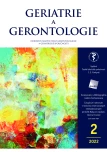Urinary incontinence in old age
Authors:
Kateřina Vlachová
Authors‘ workplace:
Centrum následné péče FN Motol Praha
Published in:
Geriatrie a Gerontologie 2022, 11, č. 2: 75-83
Category:
Review Article
Overview
The article summarizes current views on etiology, diagnosis and therapy of incontinence. Incontinence remains a persistent problem for patients and doctors. Frustrated patients fluctuate between nihilism and unrealistic notions of treatment options. Doctors have the difficult task of choosing the right examination and treatment procedure for an increasing number of patients with a number of comorbidities and the associated volume of medications used. Although there is no ideal solution for incontinence, proven knowledge and information help doctors choose an individual way for patients to manage their situation optimally.
Keywords:
urinary incontinence – diagnosis and treatment of incontinence
Sources
1. Minassian VA, Yan X, Lichtenfeld MJ, et al. The iceberg of health care utilization in women with urinary incontinence. Int Urogynecol J 2012; 23: 1087
2. Harris SS, Link CL, Tennsted SL, et al. Care seeking and treatment for urinary incontinence in a diverse population. J Urol 2007; 177: 680.
3. Herzog AR, Diokino AC,Brown MB, et al. Urinary incontinence as a risk factor for mortality. J Am Geriatr Soc 1944; 42: 264.
4. Dubeau CE, Simon SE, Morris JN. The effect of urinary incontinence on Quality of life in older nursing home residents. J Am Geriatr Soc 2006; 54: 1325.
5. Munaganuru N, Van Den Eeden SK, Creasman J, et al. Urine leakage during sexual aktivity among ethnically diverse, community-dwelling middle-age and older women. Am J Obstet Gyncol 2017; 217: 439. e1.
6. Schluter PJ, Askew DA, Jamieson HA, Arnold EP. Urinary and fecal incontinence are independently associated with fall risk among older women and men with complex needs: A national population study. Neurourol Urodyn 2020; 39: 945.
7. Morrison A, Levy R. Fraction of nursing home admissions attributable to urinary incontinence. Value Health 2006; 9: 272.
8. Lee UJ, Feinstein L, Ward JB, et al. Prevalence of Urinary Incontinence among a Nationally Representative Sample of Women, 2005- 2016: Findings from the Urologic Diseases in America Project. J Urol 2021; 205: 1718.
9. Legendre G, Ringa V, Panjo H, et al. Incidence and remission of urinary incontinence at midlife: a cohort study. Br J Obstet Gynaecol 2015; 122: 816.
10. Gorina Y, Schappert S, Bercovitz A, et al. Prevalence of incontinence among older americans. Vital Health Stat 3 2014; 1.
11. Offermans MP, Du Moulin MF, Hamers JP, et al. Prevalence of urinary incontinence and associated risk factors in nursing home residents: a systemic review. Neurourol Urodyn 2009; 28: 288.
12. Subak LL, Richter HE, Hunskaaar S. Obesity and urinary incontinence: epidemiology and clinical research update. J Urol 2009; 182: S2.
13. Al-Mukhtar Othman J, Akervall S, Milsom I, Gyhagen M. Urinary incontinence in nulliparous women aged 25-64 years: a national survey. Am J Obstet Gynecol 2017; 216: 149. e1.
14. Hannestad YS, Lie RT, Rotveit G, Hunskaar S. Familial risk of urinary incontinence in women: population based cross sectional study. BMJ 2004; 329: 889.
15. Wennber AL, Altman D, Lundholm C, et al. Genetic influence are important for most but not all lower urinary tract symptoms: a population- based survey in a cohort of adult Swedish twins. Eur Urol 2011; 59: 1032.
16. Drennan VM, Rait G, Cole L, et al. The prevalence of incontinence in people with cognitive impairment or dementia living at home: a systematic review. Neurourol Urodyn 2013; 32: 314.
17. Tähtinen RM, Auvinen A, Cartwright R, et al. Smoking and bladder symptoms in women. Obstet Gynecol 2011; 118: 643.
18. Jura YH, Townsed MK, Curhan GC, et al. Caffeine intake, and risk of stress, urgency and mixed urinary incontinence. J Urol 2011; 185: 1775.
19. Imamura M, Williams K, Wells M, McGrother C. Lifestyle interventions for the treatment of urinary incontinence in adults. Cochrane Database Syst Rev 2015; CD003505.
20. Govender Y, Gabriel I, Minassian V, Fichorova R. The Current Evidence on the Association Between the Urinary Microbiome and Urinary Incontinence in Women. Front Cell Infect Microbiol 2019; 9: 133.
21. Wood LN, Angwer JT. Urinary incontinence in women. BMJ 2014; 349: 4531,
22. Penson DF, McLerran D, Feng Z, et al. 5year urinary and sexual outcomes after radical prostatectomy: results from the prostate cancer outcomes study. J Urol 2005; 173: 1701.
23. Sobotka R, Hanuš T. Urodynamické vyšetření – indikace, provedení, interpretace. Urol praxi 2019; 20(4): 175-182.
24. Krhut J, Holaňová R, Gärtner M, Míka D. Fyzioterapie v léčbě inkontinence moči u žen. Ces Urol 2015; 19(2): 131–136.
25. Ryšánková M. Léčba stresové inkontinence žen. Urol praxi 2021; 22(2): 59–64.
26. Záleský M. Konzervativní terapie non-neurogenních dysfunkcí dolních močových cest. Urol Praxi 2021; 22(2): 65–69.
27. Radadia KD, Farber NJ, Shinder B, et al. Management of Postradical Prostatectomy Urinary Incontinence: A Review. Urology 2018; 113: 13.
28. Zachoval R, Krhut J, Záleský M, Borovička V. Různé pohledy na problematiku hyperaktivního měchýře ze strany pacienta a ze strany lékaře – specialisty. Ces Urol 2011; 15(1): 24–34.
29. Krhut J, Zapletalová O, Zachoval R, et al. Doporučení pro diagnostiku a léčbu symptomů dolních močových cest u pacientů s roztroušenou sklerózou v České republice – mezioborový konsenzus expertů dle metodiky DELPHI. Ces Urol 2017; 21(1): 20–28.
30. Mokriš J, Zachoval R, Záleský M, at al. Dysfunkce dolních močových cest u diabetických pacientů. Ces Urol 2016; 20(4): 275–284.
Labels
Geriatrics General practitioner for adults Orthopaedic prostheticsArticle was published in
Geriatrics and Gerontology

2022 Issue 2
Most read in this issue
- Non-melanoma skin tumors – basalioma, spinalioma. Overview of the disease and treatment
- Midline catheters for geriatric patients in Postacute Care Facility
- Drug interactions in gerontopsychiatry – the choice of antipsychotics and antidepressants for geriatric patients
- Urinary incontinence in old age
